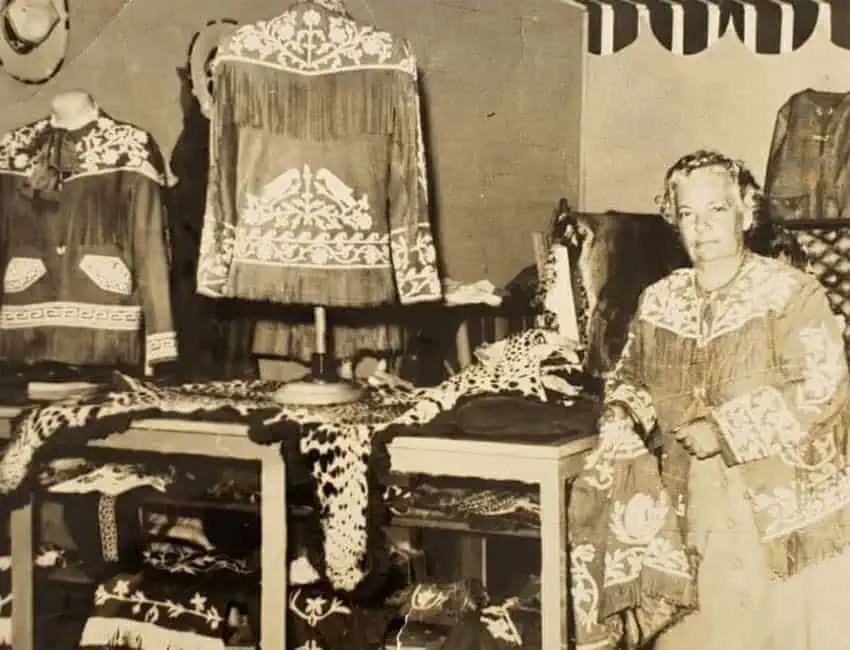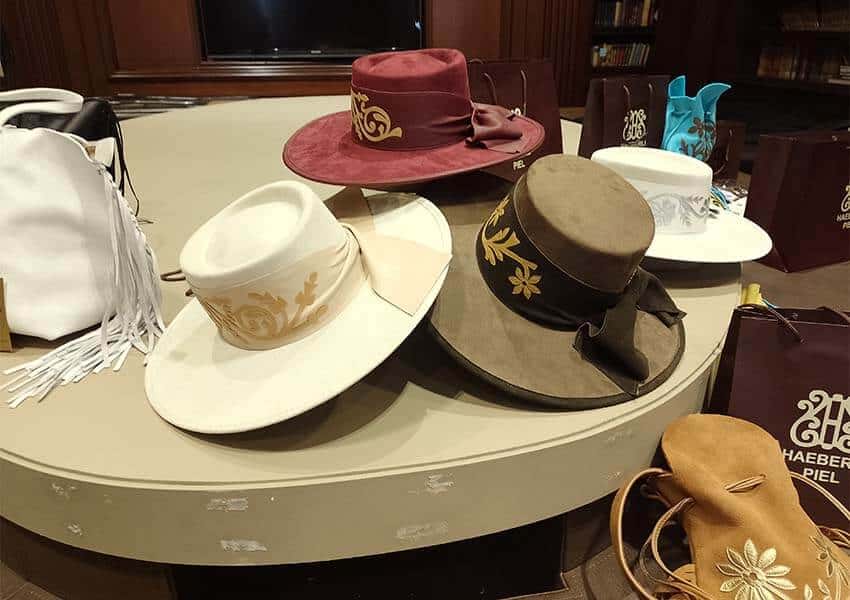From front to back: Haeberli Piel’s Anabel Rodríguez, Anabel Cárdenas and Diana Morales at Los Pinos, where they exhibited their company’s traditional and innovative clothing.
Leather coats and jackets started out as practical wear for working out on the range, but the main purpose of these garments nowadays is to make a statement. They are popular with politicians, businessmen, musicians and anyone looking to show love for Mexico’s distinctive northern culture.
Showing that love can be pricey — cueras run as high as $35,000 pesos, depending on the quality and type of leather, along with how ornately and finely it is decorated.
The small town of Tula, Tamaulipas, claims credit as the origin of the iconic jacket. Its predecessor was called a cotón, a long deerskin overcoat that cowboys wore to protect themselves from thorns and branches. During the Mexican Revolution, a general by the name of Alberto Carrera Torres contracted an artisan in this town named Porfirio Reyna Mata to make one for him. Of course, it could not be an ordinary cotón. Reyna added the floral designs and fringes, taking inspiration from Mexico’s northern indigenous culture, along with its Spanish and Arabesque heritage.
From then until the latter half of the 20th century, such decorated leather wear was exclusively for men. It proved to be extremely popular not only because of its looks but because the shortened version was practical to wear with jeans. It can also be made from different kinds of leather, which allows it to be worn in both cold as well as hot, dry conditions.
 María Luisa Martín Font in her older years working at Haeberli Piel, date unknown. Courtesy of Haberli Piel
María Luisa Martín Font in her older years working at Haeberli Piel, date unknown. Courtesy of Haberli Piel
But there was nothing like it for women until María Luisa Martín Font stepped into the picture.
The widow of a Swiss-German immigrant, she opened a shop that made bridal gowns and other specialty wear. In 1959, the then-governor of Tamaulipas Norberto Treviño Zapata, decided that the state needed a distinctive women’s outfit, much like that of the china poblana of Puebla and the huipil of the Yucatán Peninsula. He announced a competition, and Martín’s entry won.
Interestingly, her version did not include a jacket, not even a modified one. Today, Tamaulipas women do wear cuera outfits, but they now almost always have a jacket as well as a skirt. The tunic is optional.
Despite the cuera’s iconic status, there are few enterprises in Tamaulipas still making the garments by hand. Most are in Tula, but the best known is the company that Martín started after winning the state contest, Haeberli Piel. The business she named after her deceased husband is still around, located in the state capital of Ciudad Victoria, with a gallery in an old mansion in the center of the city.
Just about all of Martín’s three generations of descendants are involved in the business in one way or another, but it is run by the women of the family, principally Anabel Rodríguez Gerber, Anabel Cárdenas Rodríguez and niece Diana Morales Rodríguez.
Like Martín before them, the company continues to both preserve tradition and innovate, constantly creating new products and new colors but always using the cuera style of decoration.
In addition to jackets and skirts, they make hats of several types, boots, shoes, purses, wallets and even home decorations. The family is in charge of design and quality, but much of the work is done under contract by people in Ciudad Victoria and the surrounding area.
 An example of the Haeberli Piel company’s mix of tradition and innovation: these Spanish-style felt hats have the fancy leather trim essential to cueras.
An example of the Haeberli Piel company’s mix of tradition and innovation: these Spanish-style felt hats have the fancy leather trim essential to cueras.
Owning and wearing a cuera, in whatever form, is still extremely important to the identity of people from this state.
“… Immediately you are recognized as being from Tamaulipas, and this gives us much pride because it is a beautiful and elegant outfit. It attracts attention and is comfortable to wear at the same time,” says Cárdenas. “It will never go out of style.”
There are garments more than 60 years old that families still carefully treasure. Tamaulipas declared the cuera part of the state’s official heritage in 2016, even giving it its own day of celebration on October 20.
And the town of Tula takes great pride in being where the garment originated. It is one of the main  reasons why this little place between Ciudad Victoria and San Luis Potosí was named a Pueblo Mágico by the federal government. Mexican federal authorities have also given examples of these garments as gifts to several recent popes and various European royalty.
reasons why this little place between Ciudad Victoria and San Luis Potosí was named a Pueblo Mágico by the federal government. Mexican federal authorities have also given examples of these garments as gifts to several recent popes and various European royalty.
In 2021, Tula created a four-meter-tall monument to the jacket on a hill, impossible to miss when you visit.
